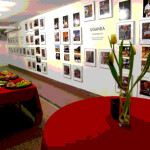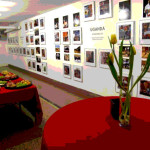The Art for AIDS Gallery- A Transformation of Space

By Daisy Oliver
(Art for AIDS volunteer coordinator)
It’ s hard to believe, that only one year ago, the gallery and venue of Art for Aids International, was nothing but a frumpy storage space. Now, as witnessed on its successful October 1, 2009 First Anniversary Opening, the space beautifully boasts the original and diverse artwork of the ever evolving Art for AIDS organization.
There is extraordinary power in a creative act that can transform something ugly into a thing of beauty. Art for AIDS International has been built upon this philosophical cornerstone.
One of its defining qualities is its ability to transform the political and moral ugliness of the AIDS pandemic into artistic statements of beauty and hope as represented in its Kids for Kids collage prints. It is, therefore, somehow fitting that the same philosophy was used in finding a physical space for our organization.
Art for AIDS International opened its new gallery in the lower level at 242 Dundas Street at the end of September 2008. The opening on Sept 26th was the culmination of a long tedious process of reclaiming a derelict and very ugly space and changing it into an oasis of serenity and beauty.
The new gallery represents a stunning achievement of creative transformation on the part of Hendrikus Bervoets, CEO of the organization and his son Jean Paul Bervoets.
Hendrikus and Jp had been searching for some time for a potential space into which Art for AIDS could move. Its ever expanding inventory of Kids for Kids prints had outgrown the basement office in the Bervoets’ home. Art for AIDS needed a larger space but the cost was a critical factor since the organization is non-profit. This meant looking at places others would consider unrentable. Consequently, it also meant copious amounts of searching.
In the late winter and early spring of 2008, the Bervoets’ found a place in the basement of a building on Dundas Street, in London, Ontario, that held promise. The site had not been used for anything other than storage in decades. It was dank, dark, and stank from mold and damp. There were no lights and no plumbing. But Hendrikus, with his refined artist’s eye, saw the latent potential of the place beyond the refuse and the rubble. It just needed some work to fix it up.
There then began a 6 month joint renovation project between the landlord, his contractors, and Hendrikus himself and whatever volunteers he could muster up to help. Ceiling tiles were taken down and hundreds of clumps of glue individually chipped off, marble floors scrapped clean of old paint, new wiring and plumbing installed, everything painted from top to bottom, new shelving and fixtures installed, new doors added. Hendrikus did much of the grunt work himself always fuelled by an inner vision of what could be. Turning something ugly into something beautiful often involves just a lot of plain old-fashioned hard, dirty work and a dream.
When you come into the Gallery now, you will see white walls highlighting the Art for AIDS prints that are softly lit with track lighting. You will see our beautiful marble floors polished to a soft gleam. At the end of the Gallery, set against a bright red wall, is a handmade receptionist’s desk over which hangs a stained glass representation of the Art for AIDS International logo.
Since its opening, the Gallery has been used for board meetings, for student events, for art workshops, for corporate luncheons and even concerts. It has become a downtown oasis for creative activity and a fun place to come visit.
The Gallery is open from Tuesday to Friday, 11am to 6 pm and on Saturdays, noon to 4 pm. We welcome visitors to come and see our wonderful space and browse our art collection. Don’t take my word on it; experience the radical transformation for yourself!
Grabbed by Art for AIDS International: A Volunteer’s Perspective
By Daisy Oliver
(Art for Aids Volunteer Coordinator)
Sometimes an idea grabs hold of one’s imagination and won’t let go.
I was first grabbed by Art for AIDS International on Dec 1st, 2006. World AIDS Day is an odd date for an anniversary but it marks the occasion when I descended the stairs into a church basement and stumbled upon an Art for AIDS display. A charming young man gave me the spiel. He introduced himself as JP Bervoets, son of founder and current art director, Hendrikus Bervoets. He was very persuasive. I would later recognize this as a family trait. I was immediately hooked on the Bervoets' vision.
Now a year after that first encounter, my home is adorned with a collection of Kids for Kids prints which continues to grow. They have also become my primary source of gift giving. In addition, I am a volunteer with the organization doing what I can when needed.
I am now the Volunteer Coordinator and also Art for AIDS No. 1 fan.
It goes back to having my imagination captured. Art for AIDS swept me off my feet with its concept that combines the themes of individual artistic expression and global social justice. In a world that frequently feels like it is going to hell in a hand basket, I recognized immediately that Art for AIDS exuded a type of transformative energy that is desperately needed to heal this planet. It’s appeal lies in its ingenious ability to foster hope on both the individual and the global levels for the common good. It is one powerful ideal.
The actual organization is rather complex because it works at multiple levels in the pursuit of its dual goals of raising public awareness of the global pandemic of HIV/ AIDS through the artistic expression of youth in both Africa and North America as well as raising funds through the sale of their artwork for HIV/AIDS relief work.
In its simplest form, however, it can be seen as a forceful instrument of transformative pedagogy. Hendrikus Bervoets, the founder of Art for AIDS and an artist by profession, is invited into a school where he talks to the students about the tragedy of the AIDS pandemic set in context of global social justice issues. They are then invited to translate that learning into an artistic statement that uses collage techniques and magazine images. Some of these collage works are then chosen to be produced into original machine-made limited edition prints which the student artist signs and then donates back to Art for AIDS. These prints are then sold publicly to raise money for carefully selected African projects that focus on assisting women and children affected by the AIDS pandemic.
There can be no finer example of learning that combines the heart, the head and the hands.
Over the last 3 years, I have watched many different pieces of art work come in and go out of the Art for AIDS inventory. I am amazed at the uniqueness and strength of the artistic vision that each piece represents in its response to global suffering. The moral caring that goes into each print is its own statement of optimism for the future and a reminder that change is possible.
With that kind of generative energy involved with Art for AIDS International, it is impossible to have too many prints. I continue to purchase new ones. It is my personal collection of hope.

